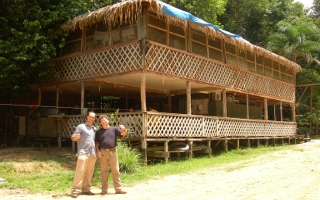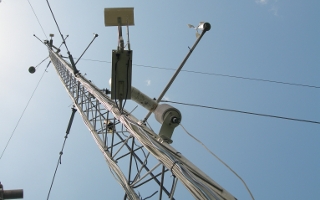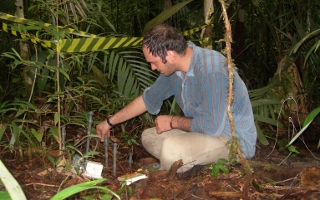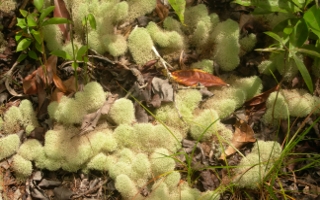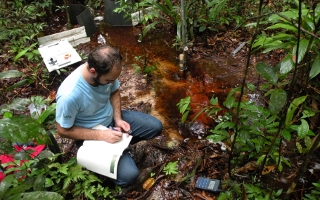Resilience of Amazonian ecosystems to reduced rainfall in relation to small-scale
topographic variation
Researcher: Fabricio B. Zanchi
Affiliation: Universidade Federal do Amazonas (UFAM) - Instituto Agricultura e Ambiente. Humaitá, Amazonas State, Brasil
Supervisors:
Collaborators:
- B. Kruit - Alterra, Wageningen
- F.J. Luizão - INPA, Manaus
- J. Tomasella - CPTEC-INPE, Cachoeira Paulista, SP
Duration: Field phases 2006-2008, analysis 2008-2012
Funding: Dutch Government NWO WOTRO Integrated Programme grant
Project outline
In Central Amazonia, the climate does not show much seasonality. The landscape generally consists of a mosaic of well-drained dissected plateaus, separated by steep slopes and broad, swampy river valleys.
Permanently wet soil status in the valley is
maintained by a continuous supply of groundwater from the plateau and slope areas.
Whilst oxisols and ultisols on the slopes and plateau have a significant clay
fraction, valley soils generally consist of strongly leached quartz sands (spodosols) with little capacity to retain water or nutrients.
Nutrients may be retained in the
valley soil by the soil carbon fraction (humus), which also may buffer the pH to some
extent, allowing tall forests to grow on these white sands. Under the present climate conditions the vegetation in the swampy valleys are not likely to experience significant drought and may even benefit from a slightly dryer climate as root water uptake, photosynthesis and decomposition may be reduced in saturated soils.
However, if reduced recharge on the plateaus and slopes would result in a significant lowering of the valley groundwater table over extended periods, soil carbon could decompose
and oxidise, leaving an extremely poor and potentially toxic soil.
This might trigger a change from the existing tall valley forest to increasingly stunted Caatinga forest
with more sclerophyllus leaves, locally called Campinarana or Campina forest.
The
local presence of Campinarana forest between the tall forest in the valley bottom and
that on the slope is an indication that a relatively small change in the valley
groundwater level may be sufficient to cause an extension of the Campinarana zone
towards the river.
Although these campina forests are quite common in the tropics,
little is known about their evapotranspiration rates.
Depending on the reduction in
rainfall and the response of different forest types we can postulate three stages of forest development:
- Reduced rainfall caused by global change and local deforestation does not affect the functioning of the rainforest on the plateau and slope. However, recharge of plateau groundwater that keeps the valleys wet is reduced, resulting in
a lowering of the valley groundwater table and reduced river runoff. The ensuing
oxidation of organic matter in the spodosols and associated change in nitrogen cycling and pH triggers a change in the forest to a more Campinarana - Campina type
of vegetation.
- The rainforest on the plateau and slope cannot maintain it's functioning and
degrades to a vegetation cover with reduced water uptake. Groundwater recharge on
the plateau and slope is maintained and the valleys remain wet. The reduction of
evaporation on the plateau and slope may partly be compensated by increased
evapotranspiration by the valley vegetation (advection) if this has not degraded to
a campina forest in the first stage.
- The reduction in rainfall is such that the rainforest on the plateau changes to
savannah, with a much lower evapotranspiration. Groundwater recharge is increased but the valley vegetation cannot compensate for the reduced evapotranspiration on
the slopes and plateau, leading to an increase in runoff. This suggests that the
valley vegetation may retain or even increase its production and evaptranspiration,
or collapse and change to a campina type of forest with presumably much reduced
production and evaporation rates.
The second possibility would mitigate the effects of a dying off of the forests on the plateau on the regional climate, whereas the first and third option represents a
positive feedback where rainfall becomes even further reduced.
Drought sensitivity of the landscape and vegetation has been investigated by
looking at soil respiration and decomposition of organic matter, canopy
photosynthesis and transpiration processes (micro-meteorology and sapflow) in different natural forest (terra-firme and valley forests, campinarana, campina) and
soil types (waterlogged sands, dry sands, unsaturated clayey soil). The investigation
focussed on the response of the ecosystem to short-term (diurnal), medium-term (seasonal) and short distance (along topographic gradients) variation in water
availability and drought. A controlled experiment lowering the water table was
included to assess the impact on organic matter in the saturated valley soils.
Research questions
- What are the variations in soil respiration and decomposition rates of organic matter in tall terra-firme forest, water-logged valley forest, campinarana and
campina forests?
- What does this tell us about the resilience to drought of the different forests and their carbon cycling and can we simulate this in a model?
- How does soil respiration, soil carbon and nutrient content change when the
saturated valley soil is (artificially) drained
- Could a change in the valley water table trigger a change from campinarana and
valley forest to a stunted campina type of forest
- What is the annual evaporation of Campina forest, and how does
evapotranspiration vary between forest types?
Project publications
- Zanchi, F.B., Waterloo, M.J., Peralta Tapia, A., Alvarado-Barrientos, M.S., Bolson, M.A., Luizão, F.J., Manzi, A.O. & Dolman, A.J. (2015). Water balance, nutrient and carbon export from a heath forest catchment in central Amazonia, Brazil. Hydrological Processes 29: 3633–3648.
- Zanchi, F.B., Meesters, A.G.C.A., Waterloo, M.J., Kruijt, B.,Kesselmeier, J., Luizao, F.J. & Dolman, A.J. (2014). Soil CO2 exchange in seven pristine Amazonian rain forest sites in relation to soil temperature. Agricultural and Forest Meteorology 192-193: 96-107.
- F.B. Zanchi (2013). Vulnerability to drought and soil carbon exchange of valley forest in Central Amazonia (Brazil). PhD Thesis. VU University Amsterdam, The Netherlands. 186 p.
- F.B. Zanchi, M.J. Waterloo, B. Kruijt, J. Kesselmeier, F.J. Luizão and
A.J. Dolman (2012). Soil CO2 efflux in Central Amazonia: Environmental and methodological effects. Acta Amazônica 42(2): 173-184.
- F.B. Zanchi, M.J. Waterloo, A.J. Dolman, M. Groenendijk, J. Kesselmeier, B.
Kruijt, M.A. Bolson, F.J. Luizão and A.O. Manzi (2011). Influence of
drainage status on soil and water chemistry, litter decomposition and soil
respiration in central Amazonian forests on sandy soils. Ambi-Agua6(1): 6-29.
- A.C. de Araúujo, A.J. Dolman, M.J. Waterloo, J.H.C. Gash, B. Kruijt,
F.B. Zanchi, J.M.E. de Lange, R. Stoevelaar, A.O. Manzi, A.D. Nobre, R.N. Lootens and J. Backer (2010). The spatial variability of CO2 storage and the
interpretation of eddy covariance fluxes in central Amazonia. Agricultural and
Forest Meteorology 150(2): 226-237. DOI: 10.1016/j.agrformet.2009.11.005
- F.B. Zanchi, M.J. Waterloo, L.J.G. Aguiar, C. von Randow, B. Kruijt, F.L.
Cardoso and A.O. Manzi (2009). Estimativa do Índice de Área Foliar
(IAF) e Biomassa em pastagem no estado de Rondônia, Brasil (Estimate of the
leaf area index (LAI) and biomass in pasture in the state of Rondônia,
Brazil). Acta Amazôica 39(2): 335-348. DOI: 10.1590/S0044-59672009000200012
Fabricio Berton Zanchi
Last modified: Wed Dec 30 13:20:58 CET 2015


